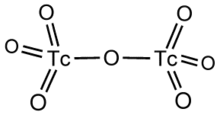Technetium(VII) oxide
Appearance

| |
| Names | |
|---|---|
| IUPAC name
Technetium(VII) oxide
| |
| Other names
Technetium heptoxide
| |
| Identifiers | |
3D model (JSmol)
|
|
PubChem CID
|
|
CompTox Dashboard (EPA)
|
|
| |
| |
| Properties | |
| Tc2O7 | |
| Molar mass | 307.810 g/mol |
| Appearance | yellow solid |
| Melting point | 119.5 °C |
| Boiling point | 310.6 °C |
| hydrolysis to HTcO4 | |
| Hazards | |
| Occupational safety and health (OHS/OSH): | |
Main hazards
|
radioactive |
Except where otherwise noted, data are given for materials in their standard state (at 25 °C [77 °F], 100 kPa).
| |
Technetium(VII) oxide is the chemical compound with the formula Tc2O7. This yellow volatile solid is a rare example of a molecular binary metal oxide, the other examples being RuO4, OsO4, and the unstable Mn2O7. It adopts a centrosymmetric corner-shared bi-tetrahedral structure in which the terminal and bridging Tc-O bonds are 167pm and 184 pm respectively and the Tc-O-Tc angle is 180°.[1]
Technetium(VII) oxide is prepared by the oxidation of technetium at 450–500 °C:[2]
- 2 Tc + 3.5 O2 → Tc2O7
It is the anhydride of pertechnic acid and the precursor to sodium pertechnetate:
- Tc2O7 + 2 NaOH → 2 NaTcO4 + H2O
References
- ^ Krebs, B. (1969). "Technetium(VII)-oxid: Ein Übergangsmetalloxid mit Molekülstruktur im festen Zustand". Angewandte Chemie. 81 (9): 328–329. doi:10.1002/ange.19690810905.
- ^ Herrell, A. Y.; Busey, R. H.; Gayer, K. H. (1977). Technetium(VII) Oxide, in Inorganic Syntheses. Vol. XVII. pp. 155–158. ISBN 0-07-044327-0.
{{cite book}}: CS1 maint: multiple names: authors list (link)
